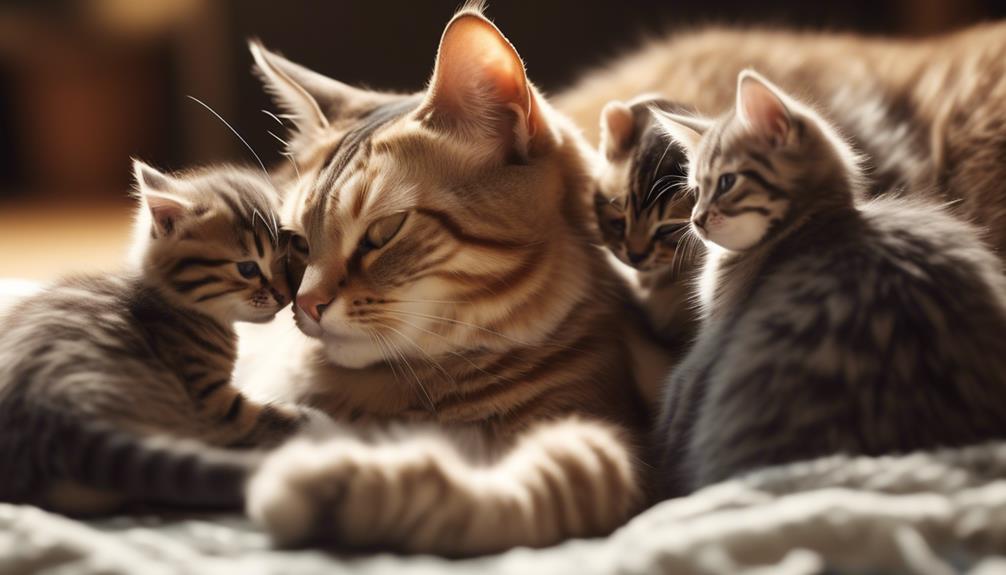Understanding the intricacies of cat reproduction behavior can provide valuable insights into the natural instincts and behaviors of these fascinating animals. From the feline reproductive cycle to the intricate mating and courtship behaviors, there are three key insights that shed light on the reproductive processes of cats.
These insights not only offer a glimpse into the biological mechanisms at play but also provide a deeper understanding of the social and behavioral dynamics within the feline world.
These insights, when examined closely, offer a window into the fascinating world of cat reproduction behavior, revealing a complex and often surprising set of behaviors and processes.
Key Takeaways
- The feline reproductive cycle, also known as the estrous cycle, involves hormonal and physiological changes in female cats.
- Mating and courtship behaviors in cats are governed by reproductive instincts, with males engaging in courtship behaviors to attract females.
- Pregnancy and birth in cats have specific behaviors and characteristics, such as increased affection and nesting behavior in expectant mother cats.
- Understanding cat reproduction behavior is important for managing cat populations, facilitating successful breeding, and providing appropriate care and support during kitten development.
Feline Reproductive Cycle
The feline reproductive cycle, also known as the estrous cycle, is a complex and meticulously regulated process in which female cats experience hormonal and physiological changes that dictate their reproductive behavior and fertility.
During the breeding season, which typically occurs in the spring and summer months, female cats undergo a series of hormonal changes that lead to the manifestation of estrus, commonly known as being in heat. This phase is characterized by increased vocalization, restlessness, and heightened affection seeking behavior towards humans and other cats.
The hormonal changes during estrus are driven by a surge in estrogen levels, which triggers ovulation and prepares the female cat for potential mating. Understanding these hormonal fluctuations is crucial for breeders and pet owners to effectively manage their cat's reproductive health.
Mating and Courtship Behavior
During the mating and courtship behavior of cats, intricate displays of feline communication and behavioral patterns are observed, providing valuable insights into the reproductive dynamics of these animals.
Mating rituals in cats are governed by their reproductive instincts, which are deeply rooted in their evolutionary history. Male cats often engage in courtship behaviors to attract females, including vocalizations, rubbing against objects, and performing a unique mating dance. This behavior serves to communicate the male's readiness to mate and establish dominance.
Female cats, on the other hand, exhibit behaviors indicating their receptiveness to mating, such as vocalizations, rolling on the ground, and assuming a mating position. Understanding these courtship behaviors is crucial in managing cat populations and facilitating successful breeding in domestic settings.
Pregnancy and Birth in Cats
Observing the behavioral patterns and reproductive dynamics during mating and courtship provides valuable insights into the subsequent stages of pregnancy and birth in cats. The gestation period for cats typically lasts between 63 to 67 days, during which expectant mother cats (queens) may display increased affection, nesting behavior, and decreased appetite.
As the due date approaches, queens may become restless and seek out quiet, secluded areas to give birth, displaying behaviors such as pacing and excessive grooming. The birthing process, known as queening, usually occurs without intervention. It is essential for cat owners to provide a quiet, warm, and safe space for the queen to deliver her kittens.
After birth, queens will instinctively care for their newborns, attending to their needs for warmth, nourishment, and hygiene. Newborn kittens are born blind and deaf, relying entirely on their mother for survival. Over the following weeks, kitten development progresses rapidly as they begin to open their eyes, explore their surroundings, and learn to walk and play.
Understanding the natural behaviors and requirements of queens during pregnancy and birth, as well as the subsequent care and development of kittens, is crucial for ensuring the health and well-being of both the mother and her offspring.
Frequently Asked Questions
What Are the Common Signs of Fertility in Female Cats?
Common signs of fertility in female cats include changes in behavior such as increased vocalization, restlessness, and affectionate behavior. Mating rituals, hormonal changes, and courtship behavior are indicative of breeding seasons and reproductive cycles.
How Do Environmental Factors Affect a Cat's Reproductive Behavior?
Environmental factors such as climate, stress, and diet can significantly impact a cat's reproductive behavior. Climate variations may influence breeding patterns, stress can disrupt fertility, and diet can affect hormonal balance, all warranting careful consideration in feline reproductive management.
Are There Any Genetic Factors That Can Impact a Cat's Ability to Reproduce?
Genetic mutations and hormonal imbalances can impact a cat's ability to reproduce, leading to genetic disorders and fertility issues. Understanding these factors is crucial in addressing and managing reproductive challenges in feline populations.
What Are Some Common Complications That Can Arise During Pregnancy and Birth in Cats?
Common complications during cat pregnancy and birth include dystocia, fetal distress, and postpartum issues. Breeding challenges may arise from fertility concerns and reproductive health issues. Understanding these factors is crucial for ensuring successful cat reproduction.
How Do Different Breeds of Cats Differ in Their Reproductive Behaviors and Cycles?
Breeding habits and reproductive cycles in cats vary across different breeds due to genetic variations. Understanding these differences is crucial for successful breeding programs and ensuring the health and well-being of both the cats and their offspring.


